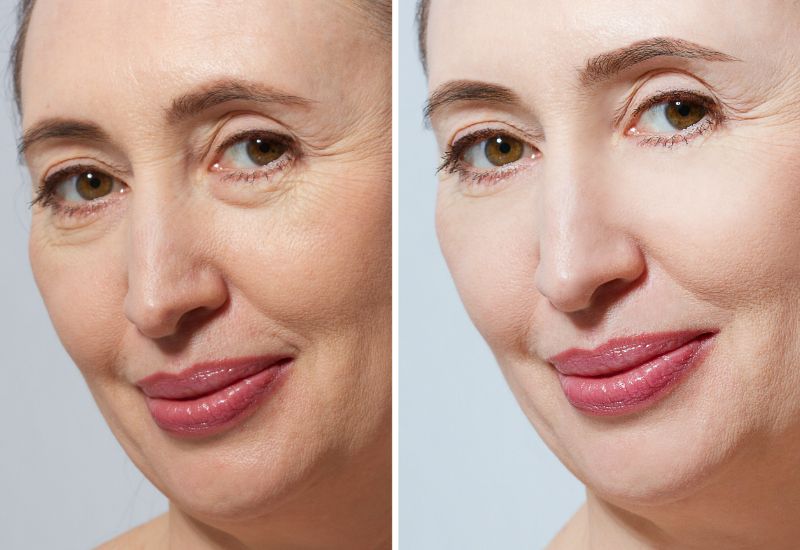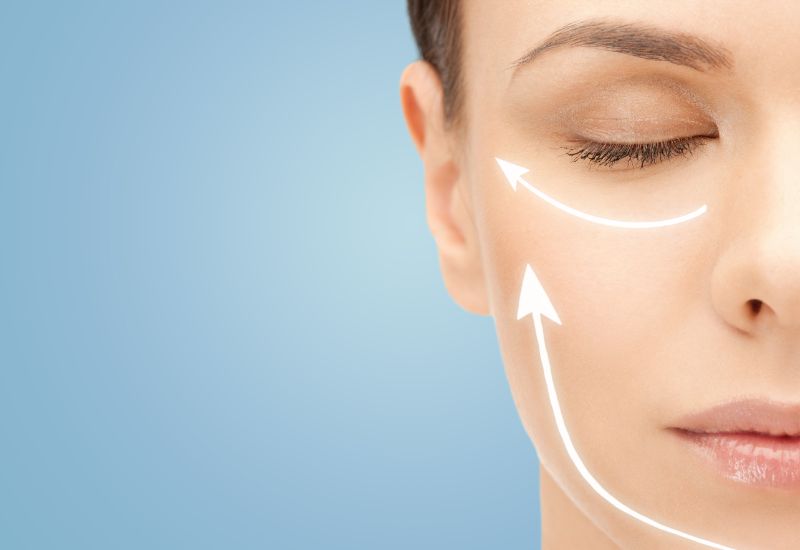A facelift, also known as a rhytidectomy, is a procedure that is used to make the skin on your face appear tighter and smoother.
Naturally, as you get older your skin starts to sag and it also loses its elasticity.
A facelift can help with this.
The effectiveness of the procedure is what makes it so common but it is not without its risks also.
In this guide, we will cover what is involved with a facelift as well as the benefits and risks involved.
Overview of facelift
A facelift is a rejuvenating technique that aims to reduce:
- Sagging skin.
- Wrinkles.
- Other visible signs of ageing.
The job of a facelift is to provide a more youthful and refreshed appearance.
During a facelift, a skilled plastic surgeon typically lifts and tightens the underlying muscles of the face, removes excess skin and repositions tissues to create a more natural and youthful contour.
The procedure can target various areas, such as your midface, jowls and neck.
This offers a comprehensive solution to combat the effects of the natural ageing process as well as other external factors e.g. sun exposure.

Why do people get a facelift?
People choose to undergo a facelift for various reasons, primarily centred around addressing the visible signs of ageing and enhancing their overall appearance.
One common motivation is the desire to reduce sagging skin and wrinkles, particularly in the face, neck, and jaw areas.
As you age, your skin loses elasticity, and facial tissues can shift and descend due to factors like sun exposure.
A facelift provides a solution to lift and tighten these areas, creating a smoother and more youthful facial contour.
You may seek a facelift to boost your self-esteem and confidence, as a rejuvenated appearance often aligns with your sense of vitality and well-being.
While non-surgical options exist for facial rejuvenation, a facelift is a more comprehensive and long-lasting solution.
This makes it a popular choice for those looking for a significant and transformative improvement in their facial aesthetics.
Different types of facelifts

Facelift surgery has evolved, and various techniques have been developed to address specific concerns and provide tailored solutions for individuals seeking facial rejuvenation.
Some of the different types of facelifts include:
- Traditional Facelift (SMAS Facelift) – This is the standard facelift procedure that addresses the lower two-thirds of the face. It involves lifting and tightening the superficial musculoaponeurotic system (SMAS), a layer of tissue beneath the skin that connects facial muscles.
- Mini Facelift – Also known as a “weekend facelift” or “S-lift,” the mini facelift is a less invasive option that targets a smaller area, typically focusing on the midface and jowls. It requires smaller incisions and has a quicker recovery time compared to a traditional facelift.
- Deep Plane Facelift – This technique involves lifting and repositioning the deeper layers of facial tissue, including the SMAS and the underlying facial muscles. It aims to provide more natural-looking and longer-lasting results.
- SMASectomy Facelift – In this variation, a segment of the SMAS is removed, allowing for a more direct and precise adjustment of facial tissues. This technique is less commonly used than other facelift methods.
- Thread Lift – A non-surgical alternative, a thread lift involves using dissolvable sutures with barbs to lift and reposition sagging facial tissue. While less invasive, the results are typically more temporary compared to surgical facelifts.
- Mid-Facelift – This procedure specifically targets the middle part of the face, addressing sagging in the cheeks and improving the nasolabial folds. It may be performed independently or in conjunction with other facelift techniques.
- Lower Facelift – Focused on the jawline and jowls, a lower facelift is designed to lift and tighten the lower part of the face, including the neck. It can be combined with other procedures for a more comprehensive rejuvenation.
- Composite Facelift – Combining elements of both the deep plane and SMAS facelifts, the composite facelift aims to provide a more holistic improvement in facial aesthetics by addressing multiple layers of tissue.
Check out our full guide to different types of facelift. Or, we also have a comprehensive guide to chin augmentation here.
How does the facelift procedure work?
Here is a step-by-step process of how a facelift typically works:
Step 1: Consultation and Evaluation
Before the procedure, the patient consults with you’ll consult with one of our world-class surgeons.
They will take a look at your medical history and discuss the procedure and what to expect.
They’ll also evaluate your facial anatomy, skin elasticity, and overall health to determine the most appropriate facelift technique.
Step 2: Anaesthesia
Facelift procedures are usually performed under general anaesthesia or local anaesthesia with sedation.
The level of edition depends on the extent of the facelift surgery.
Our surgeons will make the decision on which type of anaesthesia is suited for your procedure.
Step 3: Incisions
Your surgeon will make discreet incisions.
Often starting in the hairline near the temples, extending around the ear and sometimes into the lower scalp or along the natural creases of the face.
Incision patterns vary depending on the type of facelift chosen e.g. traditional, mini, deep plane, etc.
Step 4: Lifting and Repositioning Tissues
Your surgeon will carefully lift the skin and underlying tissues to access the muscles and connective tissue beneath the skin.
In traditional facelifts, the superficial musculoaponeurotic system (SMAS) may be lifted, tightened and repositioned for a more natural look.

Step 5: Removal of Excess Skin
Excess skin is trimmed away to create a smoother and more rejuvenated appearance.
In some cases, fat may be redistributed or liposuction may be performed to enhance facial contours.
Step 6: Closure of Incisions
The incisions are closed with sutures or other skin-closure techniques.
The choice of closure method may depend on your surgeon’s preference and your specific needs.
Step 7: Recovery
After the procedure, you will be monitored in a recovery area before being allowed to go home.
Swelling and bruising are common, and pain medication may be prescribed to manage any discomfort.
We typically advise avoiding strenuous activities and following specific post-operative care instructions.
Step 8: Follow-Up
We will schedule follow-up appointments to:
- Monitor healing.
- Check for infections.
- Remove stitches if needed.
- Assess the long-term results of the facelift.
Benefits of a facelift
Some common benefits associated with facelift surgery include:
- Improved Facial Appearance – The primary goal of a facelift is to create a more youthful and rejuvenated appearance by addressing sagging skin, deep creases and other signs of ageing.
- Tightening of Facial Muscles – Facelift surgery involves tightening the underlying facial muscles, which helps to restore firmness and definition to your face.
- Reduction of Wrinkles and Lines – By removing excess skin and repositioning tissues, a facelift can effectively reduce the appearance of wrinkles and lines, especially around the eyes, mouth and nose.
- Enhanced Jawline and Neck Contour – Facelift surgery can improve the definition of your jawline and reduce the appearance of jowls, creating a more youthful and sculpted neck contour.
- Natural-Looking Results – Using our advanced surgical techniques and skilled surgeons we aim to provide natural-looking results, avoiding an overly tightened or artificial appearance.
Risks of a facelift
Just like any other type of surgery, there are risks when it comes to facelift surgery.
Going under the knife can cause complications but thanks to today’s modern technology and techniques these cases are a rarity.
Some potential risks and complications of a facelift include:
- Adverse reactions to anaesthesia.
- Infections at the incision sites.
- Hematoma (accumulation of blood under the skin)
- Scarring.
- Temporary or permanent damage to facial nerves
- Loss of blood supply to certain areas of the skin.
- Temporary or permanent loss of hair around the incision sites.
- Asymmetry or irregularities in the final appearance.
- Prolonged Swelling or Bruising.
- Allergic reactions to surgical materials or medications.
- Delayed Healing.
With all of these risks in mind, it’s important to note that facelifts are very safe. Studies have shown this to be the case.
Facelift procedures at The New Birkdale Clinic
Facelifts are very common in the plastic surgery industry.
It’s for this reason that they have developed over the years and can be carried out efficiently and with minimal disruption to your daily life.
At The New Birkdale Clinic, we have world-class surgeons here that perform facelift procedures regularly.
Thanks to their expertise and our advanced aesthetic technology each procedure is completed successfully and produces fantastic results for our clients.
If you want to know more about our facelift procedures, reach out to us.
